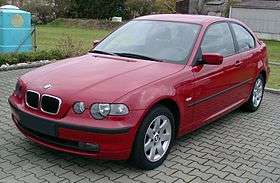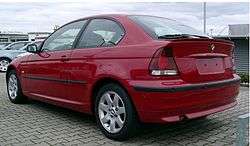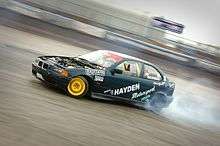BMW 3 Series Compact
| BMW 3 Series Compact | |
|---|---|
_hatchback_(2015-08-07)_01.jpg) | |
| Overview | |
| Manufacturer | BMW |
| Body and chassis | |
| Class | Hot hatch |
| Body style | 3-door liftback |
| Layout | FR layout |
| Chronology | |
| Successor | BMW 1 Series |
The BMW 3 Series Compact is a small family car, basically a truncated liftback version of the BMW 3 Series, produced by the German automaker BMW between 1993 and 2004. Initially based on the BMW E36 platform, it switched to the BMW E46 platform in 2001. Production of the 3 Series Compact ceased in 2004 when it was virtually succeeded by the 1 Series.
The car was available in 316i, 316g (compressed natural gas),[1] 318ti, 318tds (diesel) and later as a 323ti. The title 'Ti' (Turismo Internazionale), was unique to the Compact range and was used on the more powerful versions, harking back to the BMW New Class 'Ti' models of the sixties.
The 3 Series GT, based on the later, newest 3 Series, is not a successor to the 3 Series Compact, apart from their hatchback body style.
E36/5 (1993-2000)
| E36/5 | |
|---|---|
_hatchback_01.jpg) | |
| Overview | |
| Production |
1993–2000 371,498 built [2] |
| Body and chassis | |
| Platform | BMW 3 Series (E36) |
| Powertrain | |
| Engine |
1.6 L I4 1.6 L I4 Petrol/Biogas 1.8 L I4 1.9 L I4 2.5 L I6 1.7 L I4 diesel |
| Dimensions | |
| Wheelbase | 2,700 mm (106.3 in) |
| Length | 4,210 mm (165.7 in) |
| Width | 1,700 mm (66.9 in) |
| Curb weight | 1,175 kg (2,590 lb)−1,290 kg (2,840 lb) |
_hatchback_(2011-11-18)_01.jpg)
_hatchback_(2011-11-18)_02.jpg)
From the front bumper to the A pillar, the 3 Series Compact is identical to the BMW 3 Series (E36) saloon. As with the entire E36 range, the E36/5 also shares an identical wheelbase. From the A pillar rearwards, the E36/5 is unique from others in the E36 range.
The E36/5 shares its suspension with the BMW Z3; the front suspension employs the E36's standard MacPherson strut design, while the rear suspension uses a semi trailing arm from the previous model BMW 3 Series (E30).
The E36/5 made use of the older semi-trailing arm rear axle, as opposed to the E36's Z-Axle Multi-link suspension. As the trailing arm design was smaller, it allowed for a lower trunk floor height, fold-down rear seats, and an exterior undermounted compact spare tire.
The inherent design of the trailing arm suspension was that it favoured oversteer. Consequently, the BMW 3 Series Compact received mixed reviews from the automotive press; with some claiming the chassis was the most balanced of the E36 range, whilst others said that the car wandered and darted in a straight line, and was uncomposed in the corners.
Engines and performance
In North America, the sole engine available was the DOHC 1.8 litre, 138 bhp (103 kW; 140 PS) inline-four BMW M42 engine for the 1995 model year. In 1996, to make the car compliant with OBD-II, the engine was replaced by the 1.9 litre M44 unit.
Outside North America, consumers had a wider range of engine choices. The 316g could run on compressed natural gas or on petrol; when using gas it produced about 20% less power. The 316g was a strict two-seater, as the rear seat area was taken up by the gas cylinder.
| Name | Power | Torque | Size | Engine code | 0–100 km/h,s | Top speed | Years |
|---|---|---|---|---|---|---|---|
| 316i | 102 PS (75 kW; 101 hp) at 5500 | 150 N·m (110 lb·ft) at 3900 | 1596 cc | M43B16 | 12.3 | 188 km/h (117 mph) | 1994–1999 |
| 105 PS (77 kW; 104 hp) at 5300 | 165 N·m (122 lb·ft) at 2500 | 1895 cc | M43B19 | 11.9 | 190 km/h (120 mph) | 1999–2000 | |
| 316g | 82 or 102 PS (60 or 75 kW) at 5500 | 127 N·m (94 lb·ft) at 3900 | 1596 cc | M43B16 | 15.6 | na | 1995–2000 |
| 318ti | 140 PS (103 kW; 138 hp) at 6000 | 175 N·m (129 lb·ft) at 4500 | 1796 cc | M42B18 | 9.9 | 209 km/h (130 mph) | 1994–1995 |
| 144 PS (106 kW; 142 hp) at 6000 | 180 N·m (130 lb·ft) at 4300 | 1895 cc | M44B19 | 9.9 | 209 km/h (130 mph) | 1995–1998 | |
| 323ti | 170 PS (125 kW; 168 hp) at 5500 | 245 N·m (181 lb·ft) at 3950 | 2494 cc | M52B25 | 7.8 | 230 km/h (140 mph) | 1997–2001 |
| 318tds (diesel) | 90 PS (66 kW; 89 hp) at 4400 | 190 N·m (140 lb·ft) at 2000 | 1665 cc | M41D17 | 13.9 | 175 km/h (109 mph) | 1995–2001 |
Interior and trim levels

Apart from a simple one piece dashboard, the E36 Compact shared the same seats and trim as the 3 Series saloon.
The North American 318ti came in three different trim levels; Base, Active and Sport. Active package offered comfort items such as an on-board computer, cruise control, leather seats, alloy wheels, foglights and sunroof. The sport package equipped the car with M-technic suspension, foglights, alloy wheels, sport seats, and for 1995 only, a limited slip differential.
A Clubsport edition was offered in the model year 1995. The car had upgraded suspension, limited slip differential, sport seats, and full M-aerodynamic package including front and rear bumpers as well as side mirrors. It should be noted the Sport package for 1995 318ti would be identical to the Clubsport edition as had all the performance upgrades, but has no exterior distinction from the base model. Starting 1996, the sport package included the M-aerodynamic package like the Clubsport model, with the exception of standard side mirror, and the limited slip differential was no longer available. All 1999 318ti's came with the sport package.
Also there is a very rare California edition of the vehicle, introduced in 1996, featured a Webasto style folding canvas roof reminiscent of those used in the Citroën 2CV.
In 1996, to celebrate the 50th birthday of the German automobile magazine Auto, Motor und Sport handbuilt (at least) one M3 compact. The car embodied all the technical and optical characteristics of the stock E36 M3, but in the compact body, and more. A quad exhaust tip, Recaro sports seats, four-point seatbelts and an alcantara steering wheel and gear lever were specific for this model. The car was widely regarded as a test mule for the Z3 M Coupe. The car was donated to the automobile magazine, and currently resides in the M GmbH headquarters in Garching, Munich.[3]
During 1993, BMW built several prototype 5-door liftbacks, which looked outwardly even more similar to the saloon right back to the C-pillar. However, following the initially disappointing sales response to the Compact (in comparison to the Saloon & Coupe models) BMW decided not to offer a 5-door liftback variant. The prototypes were stripped and the bodyshells disposed of.
Sales
The E36 Compact was very popular in its home market in Europe, which prompted BMW to market the car to North America for the 1995 model year. The E36 Compact's front-engine, rear-wheel drive layout was unique for the segment, giving it no direct competitors in North America.
When introduced in the United States and Canada, despite being reasonably priced, starting at $19,900 (USD), the 318ti never enjoyed popularity in North America. While consumers desired a less expensive BMW, those in North American were not fond of the liftback body style.
BMW ceased importation of the BMW Compact to North America after the 1999 model year after a very short 4-year run due to a combination of poor sales, and BMW's desire to reposition themselves more upmarket by phasing out all 4-cylinder vehicles with the introduction of the new BMW E46 3-series. The failure of the E36 Compact precluded the E46 Compact's entry into the North American market.
The failure of the E36 BMW Compact in North America also prompted BMW to reconfigure the BMW Compact's ultimate successor, the BMW 1 Series, from a liftback to a coupe before attempting to market the car in North America again.
E46/5 (2000-2004)
| E46/5 | |
|---|---|
 | |
| Overview | |
| Production | 2000–2004 |
| Body and chassis | |
| Body style | 3-door liftback |
| Platform | BMW E46 |
| Powertrain | |
| Engine |
1.6 L I4 1.8 L I4 2.0 L I4 2.5 L I6 2.0 L I4 diesel |
| Dimensions | |
| Wheelbase | 2,725 mm (107.3 in) |
| Length | 4,260 mm (167.7 in) |
| Width | 1,750 mm (68.9 in) |
| Curb weight | 1,300 kg (2,900 lb)−1,405 kg (3,097 lb) |

The 3 Series Compact was redesigned in 2000 as part of the E46 line. Build and quality of finish was much-improved over that of the E36 TI. Despite this, the E46 TI was not as successful as its predecessor. The E46 version of the Compact was never marketed in North America, leaving its sole direct competitor in the class, the W203 Mercedes-Benz C-Class SportCoupé, to be the lone choice in the segment for those markets.
The E46 version of the Compact does not feature styling similar to the rest of E46 cars; most notably, the headlights were distinctively different from those of a regular E46.
The Compact was mechanically identical to the regular E46 3 Series, but featured sharper steering, with a quicker rack.
In 2004, the 3 Series Compact was replaced by the BMW 1 Series; however, the 1 Series did not appear in North America until 2008.
Engines
| Model | Years | Engine code | Power | Torque |
|---|---|---|---|---|
| 316ti | 2002–2004 | N40B16 | 85 kW (116 PS; 114 hp) @ 6100 | 150 N·m (110 lb·ft) @ 4300 |
| 2004 | N45B16 | 85 kW (116 PS; 114 hp) @ 6000 | ||
| 2001–2004 | N42B18 | 85 kW (116 PS; 114 hp) @ 5601 | 175 N·m (129 lb·ft) @ 3750 | |
| 2004 | N46B18 | |||
| 318ti | 2001–2004 | N42B20 | 105 kW (143 PS; 141 hp) @ 6000 | 200 N·m (150 lb·ft) @ 3750 |
| 2004 | N46B20 | |||
| 325ti | 2001–2004 | M54B25 | 141 kW (192 PS; 189 hp) @ 6000 | 245 N·m (181 lb·ft) @ 3500 |
| 318td (diesel) | 2003–2004 | M47D20 | 85 kW (116 PS; 114 hp) @ 4000 | 280 N·m (210 lb·ft) @ 1750 |
| 320td (diesel) | 2001–2004 | M47D20 | 110 kW (150 PS; 148 hp) @ 4000 | 330 N·m (240 lb·ft) @ 2000 |
References
- ↑ "RealOEM BMW Parts Catalog". realoem.com. Retrieved 2008-06-23.
- ↑ Eberhard Kittler: Deutsche Autos seit 1990, vol. 5. Motorbuch Verlag, Stuttgart 2001. ISBN 3-613-02128-5, p.134. Note: 2000 not included.
- ↑ "BIMMERPOST Visits BMW M's Secret Underground Garage". MarkE90M3.
External links
| Wikimedia Commons has media related to BMW 3 Series. |
| « previous — BMW road car timeline, 1980s–present | ||||||||||||||||||||||||||||||||||||||||
|---|---|---|---|---|---|---|---|---|---|---|---|---|---|---|---|---|---|---|---|---|---|---|---|---|---|---|---|---|---|---|---|---|---|---|---|---|---|---|---|---|
| Type | Series | 1980s | 1990s | 2000s | 2010s | |||||||||||||||||||||||||||||||||||
| 0 | 1 | 2 | 3 | 4 | 5 | 6 | 7 | 8 | 9 | 0 | 1 | 2 | 3 | 4 | 5 | 6 | 7 | 8 | 9 | 0 | 1 | 2 | 3 | 4 | 5 | 6 | 7 | 8 | 9 | 0 | 1 | 2 | 3 | 4 | 5 | 6 | 7 | |||
| Compact | 1 Series | E82 / E88 | ||||||||||||||||||||||||||||||||||||||
| E81 / E87 | F20 / F21 | |||||||||||||||||||||||||||||||||||||||
| 2 Series | F22 / F23 | |||||||||||||||||||||||||||||||||||||||
| F45 | ||||||||||||||||||||||||||||||||||||||||
| F46 | ||||||||||||||||||||||||||||||||||||||||
| 3 Series Compact | E36/5 | E46/5 | ||||||||||||||||||||||||||||||||||||||
| Compact executive | 3 Series | E21 | E30 | E36 | E46 | E90 / E91 / E92 / E93 | F30 / F31 / F35 | |||||||||||||||||||||||||||||||||
| 4 Series | F32 / F33 | |||||||||||||||||||||||||||||||||||||||
| F36 | ||||||||||||||||||||||||||||||||||||||||
| Executive | 5 Series | E12 | E28 | E34 | E39 | E60 / E61 | F10 / F11 | G30 | ||||||||||||||||||||||||||||||||
| Luxury | 6 Series | E24 | E63 / E64 | F12 / F13 | ||||||||||||||||||||||||||||||||||||
| F06 | ||||||||||||||||||||||||||||||||||||||||
| 7 Series | E23 | E32 | E38 | E65 / E66 / E67 / E68 | F01 / F02 / F03 / F04 | G11 / G12 | ||||||||||||||||||||||||||||||||||
| GT | 8 Series | E31 | ||||||||||||||||||||||||||||||||||||||
| Roadster | Z Series | E30 (Z1) | E36/7 & E36/8 (Z3) | E85 / E86 (Z4) | E89 (Z4) | |||||||||||||||||||||||||||||||||||
| M | 1 Series M | E82 M | ||||||||||||||||||||||||||||||||||||||
| M2 | F87 | |||||||||||||||||||||||||||||||||||||||
| M3 | E30 M3 | E36 M3 | E46 M3 | E90/92/93 M3 | F80 | |||||||||||||||||||||||||||||||||||
| M4 | F82 / F83 | |||||||||||||||||||||||||||||||||||||||
| M5 | E28 M5 | E34 M5 | E39 M5 | E60/61 M5 | F10 M5 | |||||||||||||||||||||||||||||||||||
| M6 | E24 M635CSi/M6 | E63/64 M6 | F06/12/13 M6 | |||||||||||||||||||||||||||||||||||||
| M Roadster | E36/7 (Z3) M | E85 (Z4) M | ||||||||||||||||||||||||||||||||||||||
| M Coupé | E36/8 M Coupé | E86 M Coupé | ||||||||||||||||||||||||||||||||||||||
| Sports car | E26 (M1) | E52 (Z8) | ||||||||||||||||||||||||||||||||||||||
| SUV | X1 | E84 | F48 | |||||||||||||||||||||||||||||||||||||
| X3 | E83 | F25 | G01 | |||||||||||||||||||||||||||||||||||||
| X4 | F26 | |||||||||||||||||||||||||||||||||||||||
| X5 | E53 | E70 | F15 | |||||||||||||||||||||||||||||||||||||
| X6 | E71 / E72 | F16 | ||||||||||||||||||||||||||||||||||||||
| PAV | 3 GT | F34 | ||||||||||||||||||||||||||||||||||||||
| 5 GT | F07 | |||||||||||||||||||||||||||||||||||||||
| i | i3 | I01 | ||||||||||||||||||||||||||||||||||||||
| i8 | I12 | |||||||||||||||||||||||||||||||||||||||
